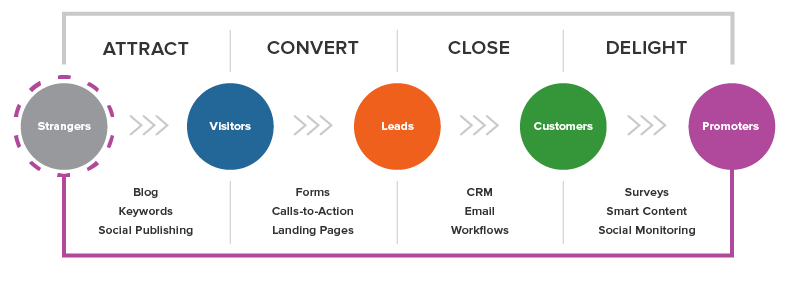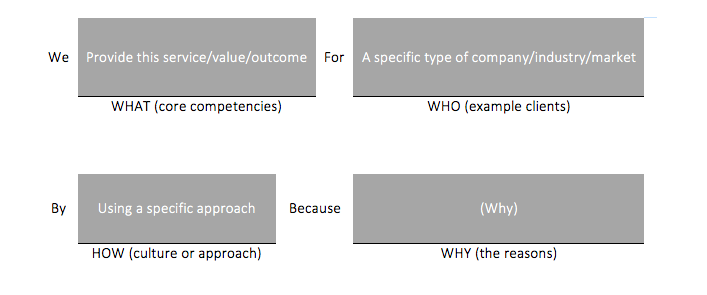The secret sauce of a successful B2B business is to always ask yourself – Why?

The complex nature of today’s buyers journey, with an increasing number of touch points across multiple communication channels and devices is making it difficult for marketers to reach out and interact with B2B buyers as easily as they would like.
To address these tough market conditions businesses have been reviewing how they interact with their target audience and the message that they’re communicating. According to Simon Sinek they have been doing their marketing in the wrong order. They start with a “what they do” and then move to “how they do it” and neglect to mention “why they do what they do”.
As Simom Sinek puts it, “People don’t buy what you do. They buy why you do it.” Understanding “why” is essential to knowing how to communicate “how” and “what” you do.
The idea of starting with “why” explains the underlying value of what you’re promoting.
Starting with why allows businesses to go beyond what they’re selling and connect on an emotional level that’s much more moving that presenting a few key product features.

Redefining Your Message
Research from Demand Gen B2B Buyers Survey Report 2016 found that the main sources of information that buyers reference were taken primarily from their web search activities, vendor websites and insights from peers.
According to Google research, B2B buyers conduct an average of 12 searches before they engage with a specific brand’s website. That means there can be between 7 – 12 touch points with a seller before a contact turns into a qualified lead, according to research from Walker Sands.
With so many touch points now in the buying process the sales cycle has become longer and more complicated. Budgets are tighter, more vendor options to consider, more stakeholders and a risk averse culture all contribute to a challenging sales cycle.
So one of the main marketing objectives is to show how your company demonstrates focus, understanding and authority to its target audience – communicated through its marketing messages.
Demonstrating You Understand Your Customers
B2B buyers have rapidly picked up from “end consumers” or the B2C market the trait of self-diagnosing their pain via the internet, in order to form an opinion on what they need to address their particular challenge.
An average customer has probably completed more than half of their decision-making process prior to engaging in any direct contact with a potential vendor – and the majority of this journey has been done via digital channels.
Research from DemandGen has shown that a website visitor is most influenced by content that provides “relevant content that speaks directly to [my] company.” It resonates because it understands their problem and connects with their situation.
So it really is a case of quality over quantity. You need to make sure that when you are producing content that it has at it’s core a target customer, and an understanding of what their problems are. Visitors are undertaking search activities with specifics in mind.

Content does need to be presented in context, so it will be valuable to show an appreciation of the wider business landscape and how a particular product, service or idea will benefit a specific business segment – without going into too much detail too early.
Visitors to a website are searching for “hot buttons” that will flag up to them whether they are on the right website or not, and if they should remain and continue to scan and read or jump off. It is over in a matter of seconds, as visitors we are looking to make up our mind within three seconds, so visual stimulus i.e. videos are a great lead magnate. We remember as much as 80% of what we see as opposed to only 10% of what we read.
Many companies may consider a relationship is over once they have made a sale. A far more rewarding approach to build with your customers is to delight them post sale, continue to engage with them and build them into promoters of your brand.
How quick and easy the user experience is to deploy your solution and the depth of your on-boarding support will set you apart going forward from other vendors.

Today’s B2B buyers may be taking longer to make purchase decisions, but they expect vendors to be timely, so you need to be ready to deal with uncertainties from new customers as they adopt and integrate your solution into an existing set-up. And keep them on track no matter the challenges so that you deliver on time.
Buyers are turning to trusted sources for advice when choosing between vendors via search, vendor websites and colleagues. So it is critical how you position your company and that you are distributing content at the time the buyer is considering their options.
Working Out Your Positioning Strategy
Writing a positioning statement is not so much about the details of your company or brand. They are more about helping your prospects work out if your company gets on the short list for consideration. If you remember those first 3 seconds when a visitor arrives on your website – these are the types questions that they are framing in their mind as they scan your home page. This is what prospects initially find most interesting – the WHY, WHO, HOW and WHAT!
When you have prepared a positioning statement, it should feel like you have reached a moment of clarity. When you are able to explain “elevator pitch” style why you do what you do, what you do as a company, who your customers are, and your company culture – you are on the first step of developing your brand and it’s message.

(Video from Simon Sinek and the Golden Circle of Why, How and What.)
A formula for your positioning statement
An effective way to start to write a positioning statement is to use the formula below so that you can break down the statement into it’s basic building blocks:

Creating A Marketing Message
Your marketing message can be taken from your positioning strategy and typically is the single most compelling claim or most persuasive product benefit that you have as a brand that solves a particular problem.
I like to develop a brand’s positioning around certain factors – the marketing message is the anchor with its strong value proposition. With every product or service there needs to be a promise, what makes you stand out from your competitors – addressing the pain of your buyer persona.
Every product has benefits that address their buyers pain points, and your positioning needs to take into account how to present those benefits so that they tap into the emotions or rational reasoning of your audience. The work you do on your buyers personas will help you to isolate the key points that you need to communicate.
When you start to communicate your message, it will need to have an effective call-to-action that compels the audience to do what you want them to do. Below is how I put all these moving parts together, with the problem you solve at the core and your most compelling claim at the top.

So How Do You Bring It All Together?
In today’s market, 67% of the buyers journey is now done digitally as buyers continually search for ways to get up to speed with their symptoms. This makes reaching and engaging with a B2B audience across a noisy, fragmented media space a difficult task. So it’s no wonder that buyers often filter out what is irrelevant at the expense of your company’s message.
An important marketing lesson to learn is that when you have a B2B product that is highly complex or technical in nature your customers may not actually be aware that they need it. So focus on addressing your buyer’s pain – talk to them about their problems. Start conversations around your buyer’s plans, goals and challenges. What options do they have, what are the consequences if they fail?
By combining a buyer persona profile, a carefully mapped buyers journey and an inbound approach you can greatly increase your engagement with sales prospects and the long term success of your lead generation programme.
Without knowing who are your ideal customers, their backgrounds, goals and problems it’s challenging to create content to attract leads. A buyer persona is the semi-fictional representation of your ideal customer, based on available market research and your own findings.
So now we have:
1. The positioning of your business
2. The definition of a target audience created from the buyer persona development
3. An understanding of the B2B business landscape and how your solution fits in
4. A marketing message that channels your most compelling claim or benefit
And as always at the heart of why we exist as a business is to have a clear and simple message on the problem that you solve.

Take Away
Sell to your customers how they want to buy. It is an important step, but thinking about the decision making process your buyers go through will help you develop a far more “buyer-centric” message strategy – use some of our tips below to get you thinking like your customers:
- Use your expertise, knowledge and experience as a way to educate prospects online especially if you what you provide has a long and complex sales cycle
- Become a trusted “expert” by sharing insights and offering advice via “social selling” to build a position of authority
- Learn how to recognise when prospects are open to engage to hear your insights and advice by creating a buyer’s persona
- Implement and use a sales CRM tool to manage and record your actions and feedback
- Sell in the way that your customers are buying

